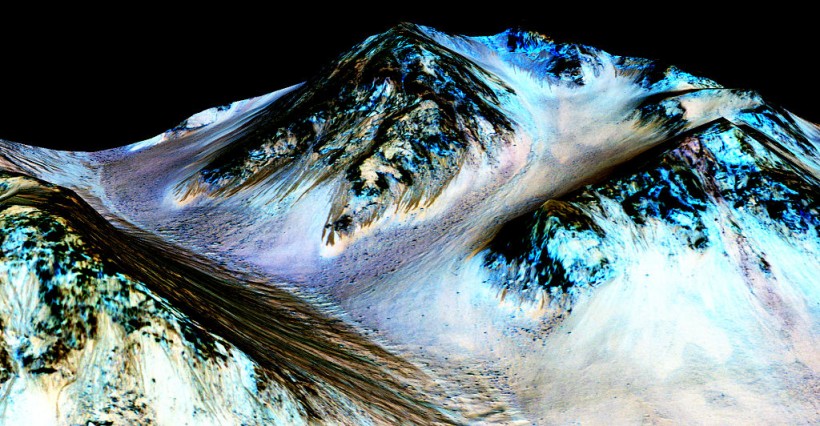A study by researchers at the University of Arizona recently said that if there were life on Mars, which is quite unlikely, conditions during the planet's infancy most probably, would have supported it.
According to Phys.org, Mars today is doubtful to maintain any form of life at the surface, dry and very cold, with a tenuous atmosphere.
Life may have thrived on #earlyMars, until it drove climate change that caused its demise @NatureAstronomy https://t.co/3PHY2XRQs2 https://t.co/3vhIz0E8WP
— Phys.org Space News (@physorg_space) October 16, 2022
However, the new research specified that the smaller, red neighbor of the Earth may have been much more hospitable four billion years back.
Many Mars experts agree that the planet began with a much denser atmosphere than it is today.
ALSO READ: NASA to Spend Approximately $93 Billion on Upcoming 2025 Artemis Moon Mission

In this handout provided by NASA's Mars Reconnaissance Orbiter, dark, narrow streaks on the slopes of Hale Crater are inferred to be formed by the seasonal flow of water on the surface of present-day Mars.
Rich in Hydrogen and Carbon Dioxide
According to professor Regis Ferriere, from the UArizona Department of Ecology and Evolutionary Biology, and one of two senior authors of the paper published in the Nature Astronomy journal, the Red Planet, rich in hydrogen and carbon dioxide, would have possibly created a temperate climate that enabled water to flow and perhaps, "microbial life to thrive."
The researchers are not arguing that life existed on ancient Mars, though if it did, explained Ferriere, their study reveals that underground Mars would likely have been habitable to methanogenic bacteria.
Such bacteria, which make a living by converting chemical energy from their environment and producing methane as a waste product, are known to be present in extreme habitats on Earth, like hydrothermal vents along fissures on the ocean floor.
There, they're supporting the entire ecosystem adjusted to crushing water pressure, almost-freezing temperatures, not mention total darkness.
Mars 4 Billion Years
The researchers tested a hypothetical scenario of an emerging ecosystem on Mars by using state-of-the-art models of the Martian crust, climate, and atmosphere, paired with an ecological model of a community of earthlike microbes that metabolize carbon dioxide and hydrogen.
On this planet, most hydrogen is tied up in the water and not often encountered on its own other than in isolated environments like hydrothermal vents.
Furthermore, its abundance in the atmosphere on Mars, nonetheless, could have offered an ample supply of energy for methanogenic microbes approximately four billion years ago, at a time when conditions "would have been more conducive to life," the researchers suggested.
Early Mars would have been quite different from what it is at present, Ferriere said, adding, toward warm and wet, instead of dry and cold, because of large hydrogen and carbon dioxide concentrations, both strong greenhouse gases that trap heat in the atmosphere.
Martian Atmosphere
The study investigators then set out to answer an intriguing question, if life flourished underground, how deep would an individual have had to go to find it?
The atmosphere on Mars would have provided the chemical energy the organisms would have required to thrive, the researchers explained, in this circumstance, carbon dioxide and hydrogen.
A similar CBS News reported that the researchers also said that the problem is that, even on early Mars, it remained very cold on the surface, so microbes would have had to go deeper into the crust to find liveable temperatures.
Based on the study findings, the atmosphere of Mars would have been changed by biological activity quite rapidly within a few tens and hundreds of thousands of years.
Related information about Mars being habitable is shown on NASA's YouTube video below:
RELATED ARTICLE: Can NASA Get Water From Moon, Mars? Virginia Tech Thinks So!
Check out more news and information on Space in Science Times.




![Aspirin Supports Immune System in Detecting and Targeting Cancer [Study]](https://1721181113.rsc.cdn77.org/data/thumbs/full/53271/89/56/50/40/aspirin-supports-immune-system-in-detecting-and-targeting-cancer-study.jpg)









